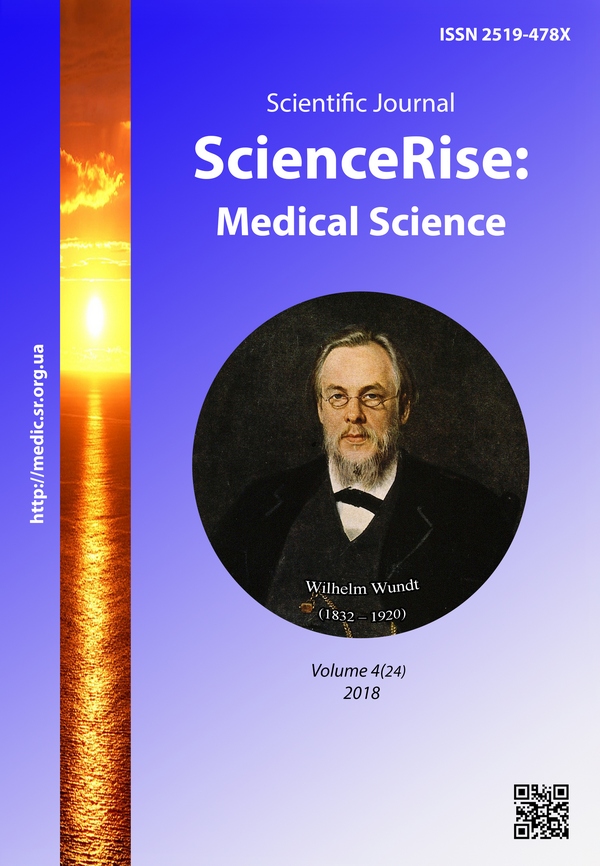Rare occupational infection: two cases of paravaccinia – viral disease of milkers at Bukovyna
DOI:
https://doi.org/10.15587/2519-4798.2018.132591Keywords:
occupational infectious disease, parapoxviruses, paravaccinia, milker’s nodules, zoonoses, rare infectionsAbstract
The article presents two clinical cases of rare zoogenous professional viral infectious disease caused by DNA-containing parapoxvirus, which is transmitted directly during contact, most often in the milking of cows, which also caused the disease to be called "milker’s nodules", but the risk of infection is also subject to butchers, farmers and agro-tourists.
The clinical course of two cases of paravaccinia is described in detail, the virus infection begins 5-15 days after inoculation in the form of a violet erythematous rounded node with a clear compression in the center and surrounding its erythematous ring.
The need for a clear elucidation of the epidanamnesis, which may facilitate differentiation with the Rhizenbach erysipeloid, skin neoplasms, contagious mollusks and anthrax carbuncle, is emphasized.
According to modern literature, in farms, the appearance of nodules may occur in people with impaired immunity, which also has an increased risk of serious complications. The nodules independently dissolve in persons without weakened immunity and heal without the formation of a scar. There is evidence that a para-vaccine virus can become a source of antigen for the development of multiform erythema.
Analyzing the data of professional foreign and domestic articles, paravaccinia is a self-limiting viral infection, the prevention of which is reduced to compliance with sanitary and hygiene rules for milking cows, animal care, the use of antiseptics in veterinary and farm.
Scientific interest in the study of the state of the immune system is susceptible to the virus, especially the clinical course of the comorbid immunodeficiency pathology of various genesis, since the question remains unclear.
The unique structure and replication process of parapoxviruses is being intensively investigated, and these data may open up promising therapeutic options for treating cancer.
General practitioners-family medicine and practitioners of other specialties-infectious disease specialists, dermatologists, oncologists and surgeons should remember the features of this infection, since the high probability of misidentification for persons who had not previously met her could lead to unwanted use of too intense methods of treatment
References
- Rubyns, A., Rubyns, S., Shepte, M., Khendler, N., Dzhannyher, K., Shvartts, R. (2017). Uzelki doil'shhits. Slozhnosti v identifikatsii infektsiy domashnikh zhivotnykh i ugroza patsientam s oslablennym immunitetom. Vestnik dermatologii i venerologi, 3, 42–47.
- Downs-Canner, S., Guo, Z. S., Ravindranathan, R., Breitbach, C. J., O’Malley, M. E., Jones, H. L. et. al. (2016). Phase 1 Study of Intravenous Oncolytic Poxvirus (vvDD) in Patients With Advanced Solid Cancers. Molecular Therapy, 24 (8), 1492–1501. doi: 10.1038/mt.2016.101
- Rintoul, J. L., Lemay, C. G., Tai, L.-H., Stanford, M. M., Falls, T. J., de Souza, C. T. et. al. (2012). ORFV: A Novel Oncolytic and Immune Stimulating Parapoxvirus Therapeutic. Molecular Therapy, 20 (6), 1148–1157. doi: 10.1038/mt.2011.301
- Groves, R. W., Wilson-Jones, E., MacDonald, D. M. (1991). Human orf and milkers' nodule: a clinicopathologic study. Journal of the American Academy of Dermatology, 25 (4), 706–711. doi: 10.1016/0190-9622(91)70257-3
- Werchniak, A. E., Herfort, O. P., Farrell, T. J., Connolly, K. S., Baughman, R. D. (2003). Milker's nodule in a healthy young woman. Journal of the American Academy of Dermatology, 49 (5), 910–911. doi: 10.1016/s0190-9622(03)02115-7
- Rajkomar, V., Hannah, M., Coulson, I. H., Owen, C. M. (2015). A case of human to human transmission of orf between mother and child. Clinical and Experimental Dermatology, 41 (1), 60–63. doi: 10.1111/ced.12697
- Adriano, A. R., Quiroz, C. D., Acosta, M. L., Jeunon, T., Bonini, F. (2015). Milker’s nodule – Case report. Anais Brasileiros de Dermatologia, 90 (3), 407–410. doi: 10.1590/abd1806-4841.20153283
- Yaegashi, G., Fukunari, K., Oyama, T., Murakami, R., Inoshima, Y. (2016). Detection and quantification of parapoxvirus DNA by use of a quantitative real-time polymerase chain reaction assay in calves without clinical signs of parapoxvirus infection. American Journal of Veterinary Research, 77 (4), 383–387. doi: 10.2460/ajvr.77.4.383
- Nafeev, A. A., Magomedov, M. A., Struchin, V. E., Kadoeva, V. B., Timofeeva, S. P. (2011). Sluchay lozhnoy korov'ey ospy. Epidemiologiya infektsionnye bolezni, 4, 56–58.
- Bennett, J. E., Dolin, R., Blaser, M. J. (2015). Other poxviruses that infect humans: Parapoxviruses (including orf virus), molluscum contagiosum, and yatapoxviruses. Mandell, Douglas, and Bennett's principles and practice of infectious diseases. Philadelphia: Elsevier/Saunders, 1703–1706.
Downloads
Published
How to Cite
Issue
Section
License
Copyright (c) 2018 Andrii Sokol, Yurii Randiuk, Aniuta Sydorchuk, Nonna Bohachyk, Yadviha Venhlovs’ka, Natalya Kaspruk, Volodymyr Tymoschuk, Orysia Oliynuk

This work is licensed under a Creative Commons Attribution 4.0 International License.
Our journal abides by the Creative Commons CC BY copyright rights and permissions for open access journals.
Authors, who are published in this journal, agree to the following conditions:
1. The authors reserve the right to authorship of the work and pass the first publication right of this work to the journal under the terms of a Creative Commons CC BY, which allows others to freely distribute the published research with the obligatory reference to the authors of the original work and the first publication of the work in this journal.
2. The authors have the right to conclude separate supplement agreements that relate to non-exclusive work distribution in the form in which it has been published by the journal (for example, to upload the work to the online storage of the journal or publish it as part of a monograph), provided that the reference to the first publication of the work in this journal is included.









